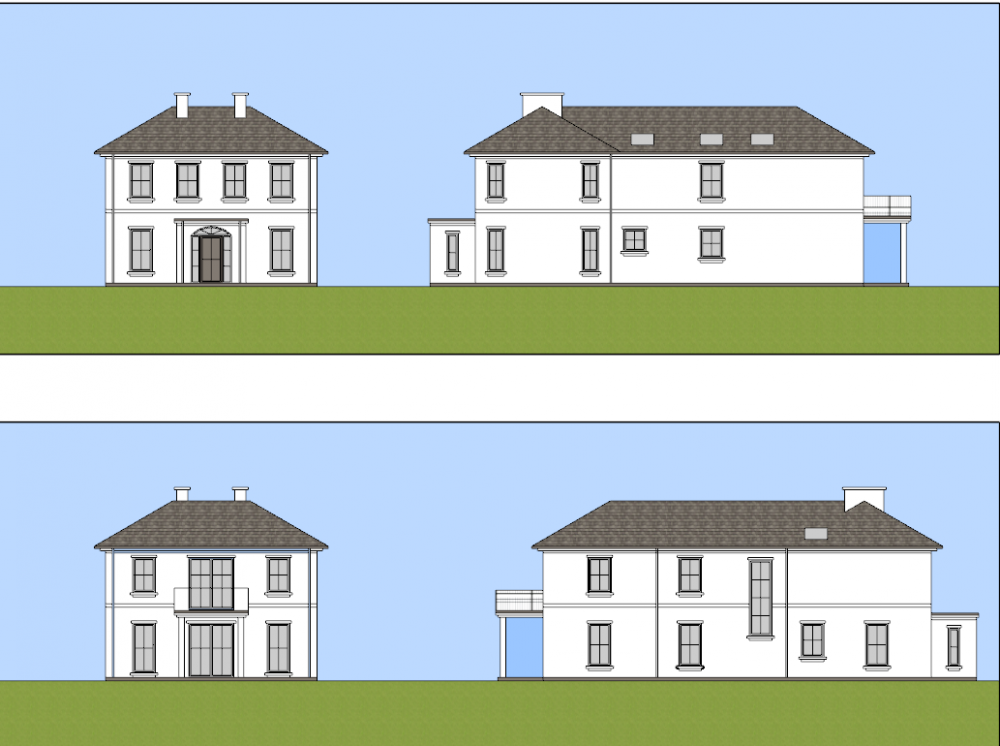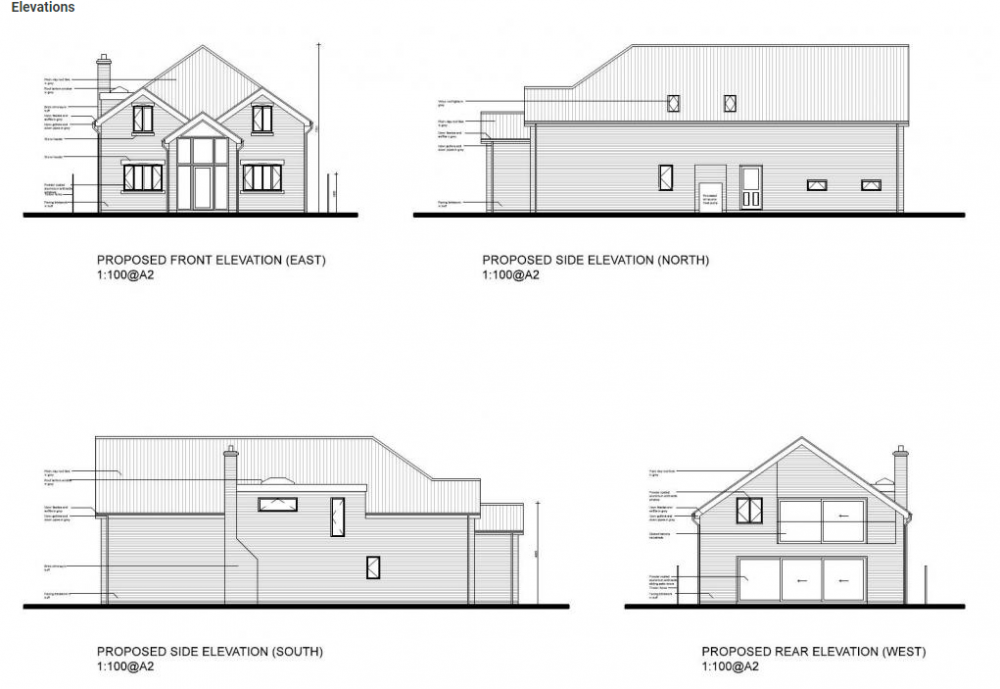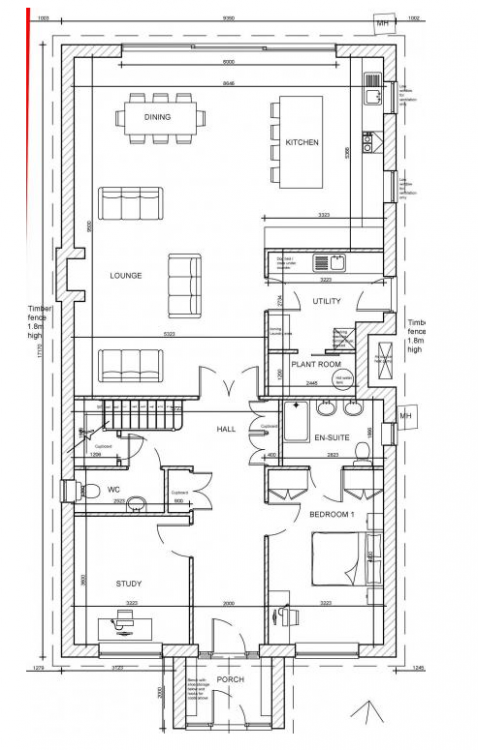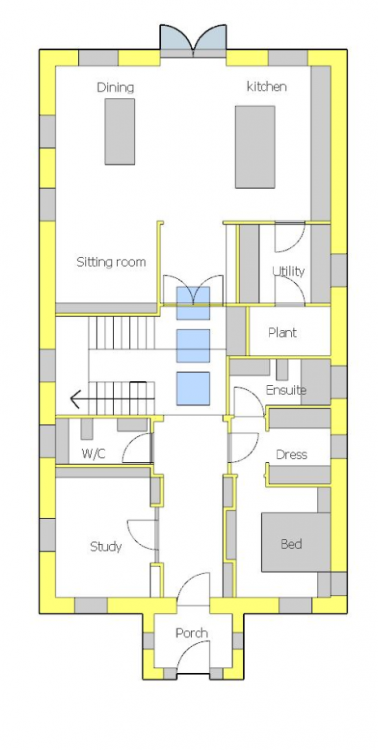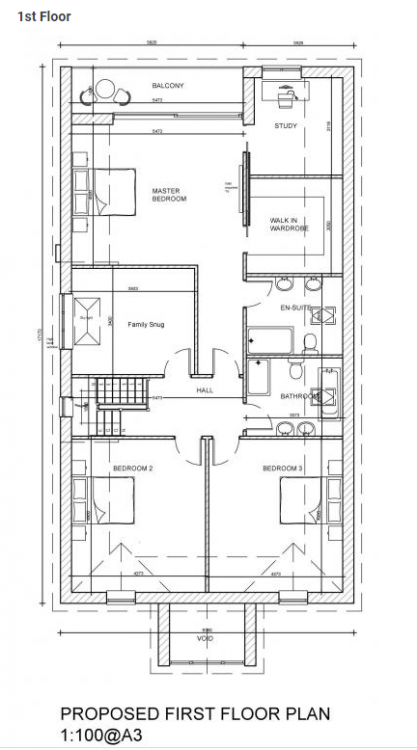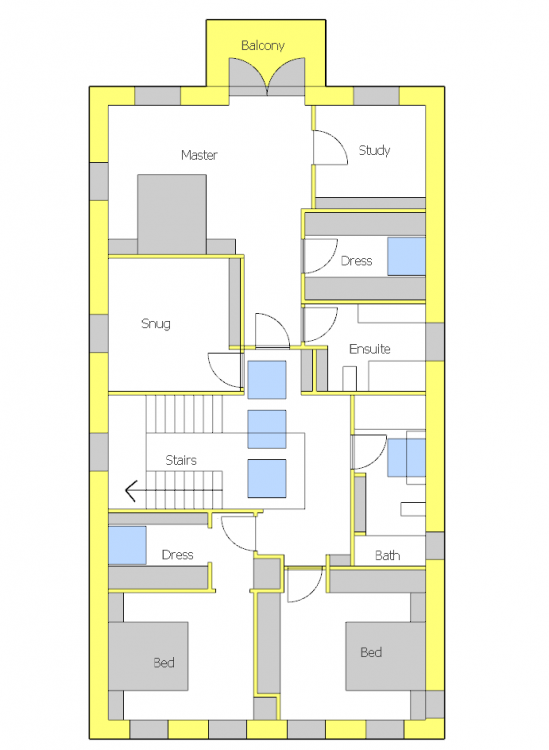Leaderboard
Popular Content
Showing content with the highest reputation on 02/01/22 in all areas
-
Do it! It can't be done once you're in. The way we look at it on ours is that figures like that challenge our budget, but we aim to be there a long time and would rather leave rooms like en-suites unfinished. We've insulated over our timber frame with a complete layer of wood fibre and it is fantastically reassuring knowing there's very little in the way of cold bridging ?3 points
-
there's nothing whatsoever wrong with the kit, it's the installation that is crap!2 points
-
Since January 5th we have used 222kWh on the ASHP over the last 26 days. That's about 9kWh per day for heating and hot water. However some days the hot water temperature has been boosted by the PV excess power going into the immersion heater so let's assume 8kWh per day for 100m2 home. The heating is running 24 hours a day at an average of 20C. The outside temperature has been low (I will look up the records later) with only about 4 nights of frost. Results from trying different programmes seems to indicate that running the heating all night at about 2C lower than day temperature uses less energy than turning it off over night and letting the building drop lower and then reheating in the morning. Some mornings at 6am it is a lot colder than between 10pm and 4am and I think the ASHP has to work alot harder in a colder temperature a lot longer to enable the house to reach the required temperature. Interestingly, when we were out all day the system used even less power to maintain temperature even though we left it running. Another item that effects these results seems to be the amount of power used in the building almost regardless of the purpose of its use. I will start keeping a record of the whole house energy use to observe the results. Another is solar gain. Others are leaving doors open for extended periods of time, and body heat from things like housework. When we were leaving the heating off in the night I noticed that the north east bedroom became colder than the rest of the house. Having installed the insulation and vapour barrier myself I reason that this is due to wind chill as this is the most exposed part of the building. The ASHP Ambient Temperature probe registered 15.6C two mornings ago at about 9.30 in the morning although it was actually only about 6C. This caused the ASHP to lower its output temperature and the house was a degree or two lower. So I have shielded the probe against direct sunlight and this seems to be working.. The weather compensation mode in the ASHP control system relates the outside air temperature to the ASHP output, in an attempt to produce the minimum heat required to satisfy the temperature required in the building. Set up correctly this will lower the temperature of the ASHP output in line with a rising outside temperature and vice versa. In my opinion, the setting of the weather compensating levels would need to be adjusted for each individual property in order to have any chance of success. Because this bungalow can over heat when the outside temperature is above 10C I have adjusted the water temperatures down in the weather compensation control area. We have not tried out the cold settings yet as the weather has been mild. The coils in the mechanical ventilation heat recovery (MVHR) ducting work well in heating mode. The air from outside , at about 5C, goes through the heat exchanger ( raising the temp to about 19C, then along one of the main supply ducts and through the heated water coil (water circulated from the buffer tank), before splitting up into outlet ducts and entering the rooms at about 26C. The cooling opperation will have to wait until the summer to be tested. Having installed additional insulation around both the hot water tank and the Buffer tank the loss of heat greatly improved. The utility room is now at about 21C unless washing is going on. I am very glad we managed to keep all the tanks etc inside the building's thermal envelope and all the 28mm pipes with maximum pipe insulation. It may be this is long and boring but hopefully someone will read this before installing an ASHP and benefit from my experience. Good luck. M The best combination:1 point
-
Looks like they've taken on a job they're clearly not up to. Another couple of tries and it might be half-decent. I think I'd go gently at first, and see what sort of response you get. I'd be surprised if a serious joinery business would be happy putting their name to that.1 point
-
When its cold. So October to April at most. No requirement outside of that.1 point
-
Check your deeds - there may be provision for repairs I'd imagine that should be possible under the Party Wall Act, if you can get planning permission.1 point
-
As Mrs Loud said "Stop right there!" @Jeremy Harris who used to frequent here had 300mm of EPS under his 100mm concrete slab. The walls and ceilings were similarly "super" insulated. He had good airtightness. He calculated 8% of his heat loss was through the slab. I'll say again he had 300mm of EPS under there.1 point
-
The ikea one is £1370, is that too expensive? Its built into the hob so if you already have that it’s not right. im not sure what you mean though, would this work for you: https://modernlivingdirect.co.uk/Online-Store/product-details/Hendrix-100-x-70cm-Ceiling-Hood-with-Inline-Motor-AU-HENDRIX.htm?gclid=Cj0KCQiA0eOPBhCGARIsAFIwTs71ebChPgdDQ85Q9qgcOprl-2tpkVHAdGymkMoxQK7Y8_0XBlvi3dEaAk2yEALw_wcB Is the section of your kitchen causing the difficulty?1 point
-
1 point
-
Ours (broadly comparable build up) £4600 for 20 m sq all in three years ago. Yours 8 times bigger, projected to be £34000. Certainly not a thief ...1 point
-
Also missing from your drawing and worth noting if you are doing any calculations, is there will be an insulation upstand from the insulation below the screed, to screed top, against the wall, I used 70mm PIR. But is more normal to use 25mm1 point
-
1 point
-
Yes I bought a flow sensor but that went off every time you have a weeee. We have now resorted to a non latching pullswitch by the side of each loo with a time delayed relay to turn it off again.1 point
-
Total agree, the fist SI was way worse, he wanted a pillar in the middle. I have to buy bigger spanners / sockets for the bolts. 36MM IIRC. 7.6M Long just shy of 800kg beam about 1100kg with columns They called it a portal frame, with the intension of stopping the front and back walls pulling away in winds etc.? although the beam is not connected to either?1 point
-
Government have already made it clear they are looking to reduce this on elec & apply it to gas! That being said, for OP, I'd stick with current boiler until it dies. Don't replace it for the sake of it. ASHP is a long term solution, space protect for it... But use your existing until it gives you an imperitive to change.1 point
-
1 point
-
Tbh I looked at a way of boosting the mvhr when a ? is done . I have a manifold of manifolds so everything has its own pipework for water feed . Therefore in theory a “ flow sensor “ on the the toilet cistern pipework could trigger the mvhr boost . But I have a million much more fun / destructive HA things to implement at the moment.1 point
-
Remember you will need an asbestos survey before any reputable contractor will touch your demolition job and if any is found, it needs to be removed by a specialist before the general demo work starts. You may get lucky and have some material that is salvageable or even sellable but decide quick and just bin if no interest or immediate use. Don't be tempted to story stuff on site 'just incase' as it will inevitably get in the way of the build and just get damaged. We had 1500 unused imperial bricks from the original 1950's build but we could not get anyone to take them, even for free. Kept getting moved around site and each time the pile would diminish as they got lost, broken etc. Still have a few left in a pile at the back. I did manage to salvage some 5m joists from the single story garage and they came in handy for a few jobs, now forming raised beds in the back garden.1 point
-
I never understand planning departments decisions/requirements to "fit in with the local vernacular". what's the point of modern architecture if no one is allowed to use it? why not allow a modern architectural house to stand out in the environment and to start a new trend. why do all houses have to be stuck in the past just to fit in? it's all b******s if you ask me.1 point
-
Ah I see. Well maybe you can get neo-Georgian - ask them. However it’s hot garbage if you do it wrong as I’m sure you probably see in your local McMansions! Usually ‘drawing things to prove it’s wrong’ is considered pandering, don’t bother with it just take their word for it. It also makes it kind of sad and ‘let she what you could have won’ *shows speedboat*. sorry if I’m being harsh but I see this every day and the clients rarely get anywhere. I’d suggest they need to tell you clearly what will get planning permission, ie, the style and size. Then you need to go on the internet and pick something nice that fits that criteria. Then let them make something similar style for you. and yes the roof… there’s hopefully a better way to do that.1 point
-
If you are going to live in the building for a long time then the more insulation the better in my book, and by the look of the snow the more the merrier!!!! Airtightness is also very important or a little more so in some ways. The cash flow is always a consideration. My thoughts are if you need to find more money (or spend less) to complete the job the way you want, then defer works that won't cause you to redo works later. I can live without an expensive kitchen for a while longer, or no garage if separate, or landscaping for example, But I want to be warm and dry with loos and showers that work with lower utility bills going forward. We insulated and sealed against air flow and installed a MVHR system when renovating our 100m2 bungalow, and replaced the night storage heaters with a bottled gas fed boiler. (no mains gas) We toyed with the idea of PV but weren't convinced that the outlay was worth it. This all changed with the arrival of the electric vehicle and the option to have an ASHP also using electricity. We now have what I think is the best combination of ASHP, MVHR, PV and EV. Would we have afforded all this at the time of building? No. However retro fitting some of the services through and airtight building has been a real pain. If you think you would fit anything later swot up on all the information on how to obtain the best from the proposed system and what the pitfalls are, and you may be able to prepare some of the things to avoid lengthy ( and costly) alterations later. Good luck. M1 point
-
So that involves installing UFH in a car garage, with significant point loads and movement from shuffling vehicles around, lifting on trolley jacks etc, sooooo, lots of cost putting at least 80-90mm of 10mm concrete mix down with next to no insulation? The recovered heat energy from the ground loops would be so negligible it would fall flat afaic, so your requisite for a "background heat of 10oC" would likely need a supply temp into UFH of north of 20oC after the delta between floor and emitter has been input to the equation. Also you'd need LOTS of the heat energy so LOTS of brine loop in huge trenches all 1000mm deep and 1500mm min apart for each pair of ground collection pipes. I do like the idea, it's just the sheer scale of this that has to provoke a reality check. The real issue would be spending good money on a failed experiment, and to not have any funds for the second attempt. Can you get a winter-long supply of dry enough wood to burn? I'd seriously look at a wood burning stove with back boiler or a second hand log gasification boiler and a TS connected to some massive ( second hand if possible ) radiators, plus the de-Strat fans. Put the WBS into a masonry cave with a bent ( curved ) sheet of stainless behind it, set back a couple of foot, to reflect the emitted heat forward only. Some internal space around it for seasoning would then ensure cheap ( green ) wood can be bought in and dried in-house to further reduce fuel costs. Electricity is soon to flatline at 30+ p/kwh and economy tariffs will fizzle out, so any direct electricity based solution will end up being far too expensive to run during the day. You can get away with quite low temp at high volume, so if you go for fan coil units you can literally just blow the warmed air directly towards yourself, so one big ASHP running at 40oC flow temp could tick the boxes with you strategizing which FCU you used subject to where you were working ( say 2 units on wheels connected to flexis which you could turn and point ). It's cost on cost whichever way you cut this, simply due to the size of the building, so the biggest focus here should be on what will be cost effective long term, so it has to be insulation and draughtproofing, so you keep whatever warmth you create inside the building. Insulation is pointless unless you go for at least 2 big de-Strat fans up high. If seasoned wood can be sourced reliably, initially, then that ( or anything else suitable that could go in a WBS ) would be my choice. Obtaining cheap / unwanted problematic green ( wet ) wood and then seasoning it yourself going forward would help keep costs down in the future.1 point
-
Does not come across well on here sometimes. I was cooking lunch, so only half a brain.1 point
-
1 point
-
Last time I did a tiled kitchen, I left long tails on the sockets and temporarily surface mounted them. Only when I did the tiling did I cut the final socket box holes to line up with the tiling and flush mounted them.1 point
-
But you do have the satisfaction of knowing where every wire goes and what the function of each relay, switch , or timer is. ?1 point
-
Or fit a monobloc heat pump. It seems bizarre to fit a split unit in that way, unless there's something about the house that we can't see on the video. Credit to the plumber for insisting on tidy pipework and cabling, even in the loft. It's good to see someone taking pride in doing a job well.1 point
-
Oof awkward. But massive kudos to you for rethinking. Why are they wasting time drawing up Georgian facades if they don’t match the area and have eves that are too high? (Hope that was free lol) Will what you have now even get planning at that height? The objective should be get planning on something buildable and within budget. For the price you are paying it should be attractive. I’m not sure you’re there yet on any of those. What styles are appropriate for your area? Can they give you better guidance?1 point
-
1 point
-
On a trading estate near me they literally sprayed the inside walls and ceiling with Icynene.1 point
-
No more like a concrete matrix. You can do a render direct to the outside. We did an internal parge coat (sand cement and lime) then battened and plasterboard with taped joints. Outside is mix of stone slips and vertical larch cladding.1 point
-
Why didn't they install the internal side of the split ASHP where the boiler used to live on the ground floor. It would have been much easier to plumb I would have thought.1 point
-
1 point
-
We are building in ICF - polystyrene blocks. We have a builder. This is our first new build and the builder whilst excellent and experienced with 30 years has never built with ICF before so a big learning curve. Builder is very conscientious and quality of work is superb. The speed of construction is a big advantage. There is very little we would change - but one thing that would have made the whole build easier is designing the openings of the house (windows doors sliders) around the size of the blocks. There is a window which is right on a corner which is not ideal when cutting ICF corners. We would also get a structural engineer who understood ICF as ours has lots of rebar which the manufacturer deems unnecessary. The blocks sit on a waterproof concrete raft with a water bar. The ICF is faced in natural stone and blockwork (to be rendered). We have not moved in yet so can't comment on how it works in reality.1 point
-
timber now coming down in price, concrete and associated products rising steeply due to energy price increases1 point
-
I'm not sure you can pluck figures out of the sky for pricing. I didn't get just TF prices within 15% of each other, from different suppliers for identical performance, so I'm not sure how it could be said that TF is/was 10-15% more expensive than masonry. In fact I had a 40% spread on just my TF quotes (Beattie Passive were a significant outlier). And, is the difference in cost the same for all performance levels. Is it really more expensive to achieve PassivHaus targets, for instance, in timber than it is in masonry. And does the cost difference include the efficiencies that can be made on the foundation/slab, for having a light weight structure, or does it just assume standard strip foundations for each?1 point
-
We're in the middle of building with thin joint masonry (so as quick and airtight as masonry can be), facing stone outer. While it *can* be neater, quicker, etc. it still relies on messy trades, and frankly their attention to detail is just not good enough for a high performance house, so unless you're there all day everyday on the details or doing it yourself, I think you'll be disappointed. I would 100% not do it again, and would go for timber frame all day long, whether clad, rendered or even with stone/brick outer. I would probably get a package company for a foundations + frame/shell build such as MBC. We got them to quote and looked into it in detail, but (unfortunately) stuck with masonry. I have no views on ICF as have no experience of it, but suspect the insurance/mortgageability is still trickier than timber frame.1 point
-
Locally to us there is miles and miles of new gas mains being installed Gas will clearly be around long after all of us have gone Hydrogen seems to be a bit of a myth With Hydrogen boilers running off a mix of 20% Hydrogen and 80% gas1 point
-
A brief update following some very active conversation with my architect this week (who also has a link to this thread and has been through the comments and other sketches). 1. They very kindly drew up a number of different Georgian options for us to consider. Not that this hadn't been considered in the past but laying it on the plot and comparing ridge and eaves heights, its clear that the georgian facade wouldn't work. The Chartered Planning consultant that's part of their firm also provided her professional opinion that the design would be out of kilter with the neighbouring plots and that the planners would take a very strong view of the proposed height of our development - which goes from 1.5 storey to 2 storeys and a loft. The end result is that we've taken their professional view into consideration and decided that it's not going to work. 2. We are in the process of looking at alternative options to pretty up the front facade, which includes the increased glazing on the 1st floor windows, different fenestration options amongst other things. I hope to get updates from them by the end of this week. 3. I've asked them to reconsider the roof design and we're looking to incorporate some rooflights/velux windows to bring more light into the centre of the house and change the design of the front gables so that it allows us to take the glazing all the way to the roof. This will mean a revised roof design and adding considerable cost - so we're considering our options here - but this is something that can be tweaked at a later stage, after planning has been granted.1 point
-
99% of windows are not fitted with EPDM. Why does it need to be bonded to the cavity closer? Bonded to frame and to inner leaf will stop moist indoor air causing issues.1 point
-
@Indy I've been plugging away at this for a couple of hours on sketchup. First here are the elevations continuing in the style as before. As before I have no idea if the neighbours will be overshadowed or overlooked badly with this design. The council may be dead set against it too. Obvious points to note are. 1. Same footprint as your existing design. 2. Simplified roof. Just a hip roof with a flat GRP rectangle in the centre. 3. Fake chimneys only. 4. Open porch/balcony added to the rear. BEFORE AFTER Now for the floor plans. BEFORE + AFTER The foot print is the same I;ve done my best to keep the positioning and sizes of the rooms as you had them. Changes to note: 1. I've added side windows to the porch. 2. The hallway is more defined and has built in storage. 3. The study has an additional south facing window, built in book shelves and a glazed door with sidelights to brighten the hallway. The Storage opposite is symetrical. 4. The generous sized WC (wheelchair accessible size) has a south facing window and the door into the hall has a fanlight to do the same. Symetrical with the door to the visitors suite opposite. 5. The Visitors suite enters into a large dressing area with a tall window. The bedroom has an extra window and some shelving. It is further removed from the hallway for privacy and noise. 6. The central hallway is the part of which I am most happy! The staircase is much more of an event, fitting of such a larger house. Storage underneath. The South facing tall window will give tremendous light. Above is a surrounding wrap around landing and in the flat roof 3no 1m2 velux flat roof lights. 7. I've removed the niche for the ASHP. it would be more effective in the front garden with a stylish screen. Where it is it's awkward to build around and might be continuously defrosting due to lack of airflow. Also I'm not too enamoured with such a high current device enclosed on all but one side by the house re fire. Domestic bliss calling here............................................ I'll finish when I get a chance!1 point
-
This is what my system controls would look like if I didn't have a computerised home automation system: Wait a minute, I haven't got a computerised home automation system!0 points
-
Yes, its quite large. But those trees are tall. So in winter the roof loses the sun quite early. Nice idea. Will need to try that. Wonder what that will produce?. Are you popping in for a cup of steamy tea?0 points
-
0 points
-
All that automation and you have to press a button? I was expecting a rim mounted break-beam detector or something... ?0 points
-
A man that takes a problem and claims there is no problem is a woman. A man that takes a problem and complicates it so it's a problem for another man is a CHAMPION! The said 2nd man needs to man up .0 points
-
I hope the author 'Andy M' isn't 'Andy Marshall' (Sales Director for TKC Kitchens)... ?0 points
-
0 points
-
Having lived in Weymouth, Portland has many more problems than just wind. Have refrained for mentioning the unmentionable.0 points
-
0 points
This leaderboard is set to London/GMT+01:00















.thumb.jpg.bac90f3bbf6868cf2118d010d936c99d.jpg)

